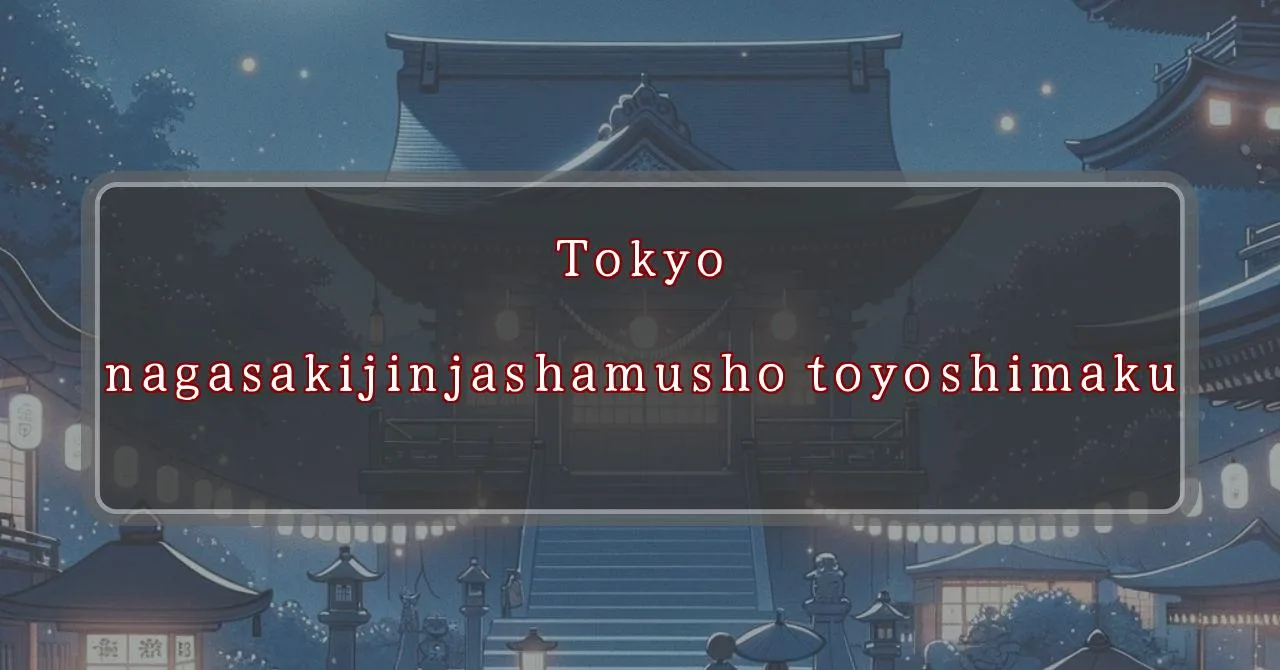Enchanting shrine festival illuminates the autumn sky
Basic Information
Nagasaki Shrine is a Shinto shrine located in Toshima Ward, Tokyo, Japan. It is dedicated to the deities Susanoo-no-Mikoto and Kushinada-hime-no-Mikoto.
- Address: 1-9-4 Nagasaki, Toshima-ku, Tokyo 171-0051
- Phone Number: 03-3957-0481
- Access: 1-minute walk from Shiinamachi Station, Seibu Ikebukuro Line
- Festival Days: Second Sunday of September
Main Events and Attractions of the Festival
The Nagasaki Shrine Festival is a lively and colorful event that attracts many visitors each year. The festival features a variety of events and attractions, including:
Mikoshi Procession
The highlight of the festival is the mikoshi procession, which takes place on the second Sunday of September. A mikoshi is a portable shrine that is carried through the streets by a team of people. The Nagasaki Shrine mikoshi is a large and elaborate structure, and it is a sight to behold as it is carried through the streets. The procession is accompanied by music and dancing, and it is a festive and joyous occasion.
Shishimai Dance
The shishimai dance is a traditional Japanese dance that is performed at many festivals. The dance is performed by two people, one of whom wears a lion costume and the other of whom plays a drum. The lion costume is very elaborate, and it is said to bring good luck to those who see it. The shishimai dance is a popular attraction at the Nagasaki Shrine Festival, and it is sure to delight visitors of all ages.
Food Stalls
No Japanese festival is complete without food stalls, and the Nagasaki Shrine Festival is no exception. There will be a variety of food stalls selling a variety of delicious treats, from traditional Japanese dishes to more modern fare. Visitors can also enjoy a variety of drinks, including beer, sake, and soft drinks.
Entertainment
In addition to the mikoshi procession, shishimai dance, and food stalls, the Nagasaki Shrine Festival also features a variety of entertainment, including live music, dancing, and games. There is something for everyone at the Nagasaki Shrine Festival, and it is a great opportunity to experience Japanese culture and traditions.
Blessings and Deities
Nagasaki Shrine is dedicated to the deities Susanoo-no-Mikoto and Kushinada-hime-no-Mikoto. Susanoo-no-Mikoto is the god of storms, seas, and agriculture, while Kushinada-hime-no-Mikoto is the goddess of fertility and marriage. The shrine is said to bring blessings of good fortune, prosperity, and protection against evil.
Origin and History
The origins of Nagasaki Shrine are unclear, but it is believed to have been founded in the Edo period (1603-1868). The shrine was originally known as Jurosetsu-no-Yashiro, and it was dedicated to the ten goddesses of fortune. In 1874, the shrine was renamed Nagasaki Shrine and dedicated to Susanoo-no-Mikoto and Kushinada-hime-no-Mikoto.
Tips and Notes for Visitors
When visiting Nagasaki Shrine, please be sure to follow these tips and notes:
- The shrine is open daily from 9:00 AM to 5:00 PM.
- Admission to the shrine is free.
- Photography is permitted within the shrine grounds.
- There is a small parking lot available for visitors.
- The shrine is a popular destination for weddings and other ceremonies, so it is best to avoid visiting during these times.
Parking Information
There is a small parking lot available for visitors to Nagasaki Shrine. The parking lot is located next to the shrine, and it can accommodate up to 10 cars. The parking fee is 500 yen per day.
Popular Stalls and Food Carts in Recent Years
| Type of Stall | Description |
|---|---|
| Takoyaki | A staple at Japanese festivals. Characterized by a crispy outside and a creamy inside. |
| Jaga Butter | A simple yet popular snack of hot potatoes lavishly topped with melted butter. |
| Baby Castella | Small castella cakes, sweet and fluffy treats enjoyed by children and adults alike. |
| Grilled Ayu with Salt | Fresh ayu fish grilled whole with salt, a savory taste of Japanese summer. |
| Shaapin | A unique gourmet item influenced by foreign cuisine, with a chewy skin wrapping the filling. |
| Okonomiyaki | A Japanese grilled dish where you often choose your own ingredients for a personalized flavor. |
| Cotton Candy | A fluffy, sweet snack that’s extremely popular with children. |
| Chocolate Banana | A banana coated in chocolate, a fun and visually appealing dessert. |
| Kushiyaki | Various types of ingredients skewered and grilled, an easy-to-enjoy snack. |
| Yakisoba | Fried noodles mixed with a special sauce, a fast food favorite in Japan. |



